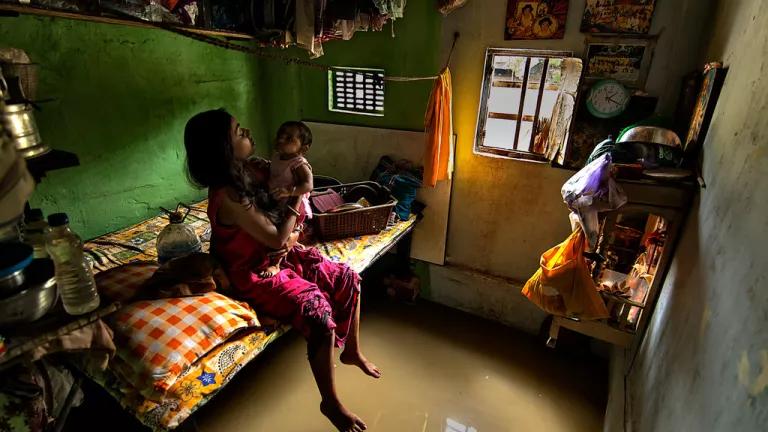The Need to Improve Student Literacy in Climate and Health
The climate crisis endangers children’s health, but few students are learning how to respond.

Credit: U.S. Centers for Disease Control and Prevention
The climate crisis endangers children’s health, but few students are learning about these risks.
Co-authored by Valerie Stull, Maggie Grabow, and Jonathan Patz (University of Wisconsin-Madison)
From sweltering heat waves to raging wildfires to deadly storms, climate change is affecting every single one of us across the globe and threatening our health. And while we’re all endangered by this problem, the adverse impacts fall disproportionately on people who are least equipped to deal with them, such as children.
Kids are particularly vulnerable to climate-fueled health risks because of their still-developing bodies and organ systems and reduced capacity to anticipate and prepare for complex, growing threats on their own. The climate problem is a barrier to growth and long-term health of children, but it’s also harming young people right now: for example, air pollution from fossil fuels damages children’s lungs and limits recreational opportunities, wildfires and extreme storms force school closures and evacuations, and extreme heat impairs cognitive function.
Recognizing these threats—and the immense risks of climate change for the lives of all children absent real, meaningful action—the emerging youth climate movement has recently demanded policymakers act aggressively to transition our world to a clean energy future. In doing so, young leaders have drawn upon the mountains of scientific evidence to correctly describe the climate threat as an obstacle to their well-being, safety, and ability to achieve life’s full potential.
Despite the considerable evidence pointing out the tangible harms inflicted on children from fossil fuels, teaching of climate change as a health emergency is relatively rare—especially at the K-12 level.
In work published this week in the journal Health Affairs, we explore a potential solution to this deficiency, by envisioning a framework for teaching students at all levels crucial concepts in a topic we define as climate and health literacy.
Our analysis draws upon the work of the U.S. federal government which has developed fundamental principles of climate literacy, a framework that breaks down the science of the climate crisis into clear, concise, and compelling building blocks. These seven principles explain how climate change happens, what role humans play in causing climate change, and why it matters.
But despite the detailed discussion of all the consequences related to climate change in that framework, human health problems receive limited attention—even though the climate crisis could contribute to unprecedented, widespread human suffering and shoulder vulnerable people with huge healthcare bills for years and years to come if we fail to act. Since there’s been little consensus to date about the dimensions of climate change and health that merit focus in K-12 educational curricula, the topic has not yet received widespread attention. That’s why we set out to develop principles of climate change and health literacy—to help accelerate efforts and attention to teaching students about these risks and our options to reduce them.
Our climate and health literacy teaching framework identifies key concept areas to organize curriculum on this important topic.
SEVEN PRINCIPLES OF
CLIMATE AND HEALTH LITERACY
1. Root cause: the climate crisis is caused by our burning of fossil fuels.
2. Mechanism: climate change affects global temperatures, sea level rise, and the water cycle.
3. Determinants: our mental and physical health is closely linked to environmental conditions.
4. Implications: climate change will worsen existing health disparities.
5. Interventions: we can reduce the health harms of climate change through actions to cut carbon pollution and prepare communities for climate impacts.
6. Evidence: our understanding of how climate affects health is based on a wide array of data and models.
7. Complexity: the effects of climate change on health are complex and vary by place and time.
As students advance through schooling, they can delve deeper into the linkages between change and health through this set of principles, expanding from basic knowledge of the root cause to more comprehensive understanding of the available evidence and existing complexity. For students in health professions, additional tools like a set of competencies developed by the Global Consortium on Climate and Health Education has developed can also inform their training.
In our publication, we explore the existing research literature at the intersection of climate, health, and education to assess how well it engages with these seven thematic areas. Overall, we find that while basic climate concepts are represented in many published papers that outline climate change education, far fewer of them spotlight health disparities and policy solutions. It’s clear that a more well-rounded effort to provide K-12 students with foundational competencies in climate and health topics can bolster a more inclusive, diverse, and effective climate movement.
By equipping younger learners with knowledge about the importance of climate change to health, students can learn how to help to shape the many solutions that are coming to the fore, and take action as individuals, professionals, and members of a growing and vibrant global movement for science-based and people-centered climate policy. The success of the climate movement over the long haul depends on whether or not we choose to empower today’s youngest learners with this key knowledge.



